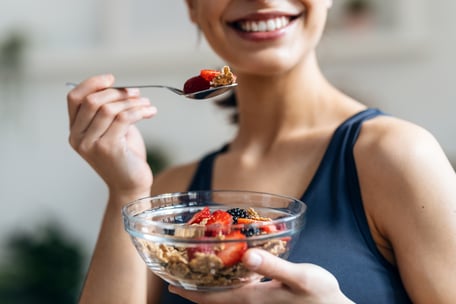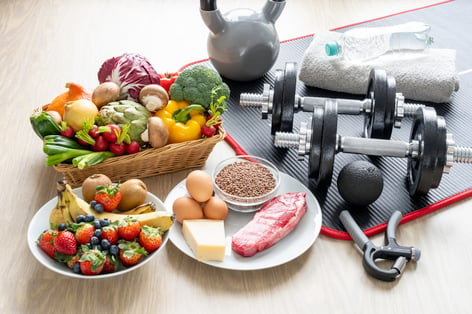 The holidays are a time of joy, celebration, and indulgence, but they can also disrupt our daily routines. Whether you’ve been traveling, enjoying family time, or indulging in festive foods, getting back into a fitness and nutrition routine can feel daunting. If you’re ready to refocus and regain your momentum, here are some practical tips to help you reset and thrive.
The holidays are a time of joy, celebration, and indulgence, but they can also disrupt our daily routines. Whether you’ve been traveling, enjoying family time, or indulging in festive foods, getting back into a fitness and nutrition routine can feel daunting. If you’re ready to refocus and regain your momentum, here are some practical tips to help you reset and thrive.
Focus on Nutrition Basics
Holiday treats are enjoyable, but now is the time to return to balanced eating. Start by incorporating more whole foods into your meals, such as lean proteins, fruits, vegetables, and whole grains. Meal prepping can also be a game-changer. Preparing your meals in advance ensures you have nourishing options ready when life gets busy. Once you’ve started nourishing your body with balanced meals, reintroducing regular physical activity can feel even more manageable and rewarding.
Start with Small Steps
After time away from your regular routine, it’s tempting to dive back in full force. However, starting small allows you to build mental wins that boost confidence and motivation. For example, committing to just a couple of gym sessions per week or taking a daily 15-minute walk can create a sense of accomplishment. These small victories lay the foundation for more ambitious goals, helping you gradually build momentum and reestablish healthy habits.
Prioritize Consistency Over Intensity
Consistency is the cornerstone of sustainable progress. Even if your workouts feel less intense than before, showing up regularly matters more. Consider scheduling your workouts as you would a class or meeting. Having a set time can help re-establish the habit and keep you accountable.
Revisit Your Goals
Use this post-holiday period as an opportunity to reflect on your fitness and health goals. Are they still aligned with your current priorities? If not, adjust them. Setting realistic and specific goals—like improving your squat strength, running a 5K, or simply feeling more energized—can reignite your motivation.
Stay Hydrated and Rested
Hydration and sleep are often overlooked but are crucial for recovery and performance. After holiday travel or late nights, prioritize getting enough quality sleep and drinking plenty of water. These simple actions can boost your energy levels and improve workout performance.
Seek Support
If you’re struggling to find motivation, consider teaming up with a friend or joining a group fitness class. Accountability partners can make the process more enjoyable and help you stay on track. If you need personalized guidance, a Registered Dietitian or fitness coach can provide tailored advice to meet your goals.
Celebrate Small Wins
As you ease back into your routine, celebrate small milestones. Whether it’s completing your first workout of the year or preparing a week’s worth of healthy meals, acknowledging progress keeps you motivated and builds momentum.
Getting back into a routine after the holidays doesn’t have to be overwhelming. By focusing on small, sustainable changes and prioritizing consistency, you can set yourself up for a successful and rewarding year ahead. The most important thing is to start—progress, not perfection, is what truly matters.
Looking for a way to get your goals started? Try with our new fitness program, We Win Together! Start with a personalized strategy session to set a SMART goal and create weekly action plans with your NIFS staff member. Stay motivated through individual check-ins, group meetings, and support from a like-minded wellness team. Sign up today and take the first step toward a healthier, more empowered you!


 As the seasons shift and fall settles in, it’s the perfect time to take advantage of the bountiful seasonal produce that boosts your nutrition and supports an active lifestyle. The cooler weather and fresh produce available at this time of year provide not only a delicious variety but also essential nutrients that help you stay energized, strong, and healthy. Whether you’re training for a race, hitting the gym, or simply maintaining your fitness routine, embracing fall produce can give your body the fuel it needs.
As the seasons shift and fall settles in, it’s the perfect time to take advantage of the bountiful seasonal produce that boosts your nutrition and supports an active lifestyle. The cooler weather and fresh produce available at this time of year provide not only a delicious variety but also essential nutrients that help you stay energized, strong, and healthy. Whether you’re training for a race, hitting the gym, or simply maintaining your fitness routine, embracing fall produce can give your body the fuel it needs.


.jpg?width=422&height=281&name=GettyImages-1423997728%20(1).jpg) In the realm of fitness and nutrition, the term "caloric deficit" often takes center stage. But what exactly does it mean, and why would someone actively pursue it? Let's break it down.
In the realm of fitness and nutrition, the term "caloric deficit" often takes center stage. But what exactly does it mean, and why would someone actively pursue it? Let's break it down. As athletes, we understand the importance of fueling our bodies properly to perform at our best. Whether you're hitting the gym regularly, training for a marathon, or simply aiming to lead a healthy lifestyle, how you balance your plate can significantly impact your energy levels, recovery, and overall well-being. That's why I'm introducing the concept of "Performance Plates" – a simple yet effective way to structure your meals based on your activity level and goals.
As athletes, we understand the importance of fueling our bodies properly to perform at our best. Whether you're hitting the gym regularly, training for a marathon, or simply aiming to lead a healthy lifestyle, how you balance your plate can significantly impact your energy levels, recovery, and overall well-being. That's why I'm introducing the concept of "Performance Plates" – a simple yet effective way to structure your meals based on your activity level and goals.
 Summer is the perfect time to rejuvenate not only your spirit but also your diet. The warmer months bring an abundance of fresh produce, longer days, and a general sense of renewal, making it an ideal time to experiment with new nutritional habits. Here’s how you can make the most of summer by trying new things in your diet.
Summer is the perfect time to rejuvenate not only your spirit but also your diet. The warmer months bring an abundance of fresh produce, longer days, and a general sense of renewal, making it an ideal time to experiment with new nutritional habits. Here’s how you can make the most of summer by trying new things in your diet.
 For athletes and gym enthusiasts, performance and recovery are top priorities. While protein often takes center stage in their nutrition plans, there's an unsung hero that deserves more spotlight: dietary fiber. This essential nutrient, found in fruits, vegetables, whole grains, and legumes, plays a crucial role in maintaining not just overall health, but also enhancing athletic performance and recovery.
For athletes and gym enthusiasts, performance and recovery are top priorities. While protein often takes center stage in their nutrition plans, there's an unsung hero that deserves more spotlight: dietary fiber. This essential nutrient, found in fruits, vegetables, whole grains, and legumes, plays a crucial role in maintaining not just overall health, but also enhancing athletic performance and recovery.
.jpg?width=391&height=347&name=GettyImages-1261754581(2).jpg) The Cornerstone of Nutrition: Caloric Intake
The Cornerstone of Nutrition: Caloric Intake.jpg?width=480&height=309&name=GettyImages-1448979924(2).jpg) In today's fast-paced world, where new diet trends and health fads emerge almost daily, it can be challenging to discern what truly benefits our bodies. Amid this whirlwind of ever-changing advice, the key to a healthier life may not lie in exotic superfoods or rigorous diet regimens, but in the consistent practice of nutritional basics.
In today's fast-paced world, where new diet trends and health fads emerge almost daily, it can be challenging to discern what truly benefits our bodies. Amid this whirlwind of ever-changing advice, the key to a healthier life may not lie in exotic superfoods or rigorous diet regimens, but in the consistent practice of nutritional basics.
 If you’ve been into fitness for a while, you likely know how important it is to fuel and replenish your body before and after exercise with the proper nutrition. However, you might be uncertain and confused about why, when, and what to eat and drink to optimize your workouts.
If you’ve been into fitness for a while, you likely know how important it is to fuel and replenish your body before and after exercise with the proper nutrition. However, you might be uncertain and confused about why, when, and what to eat and drink to optimize your workouts.